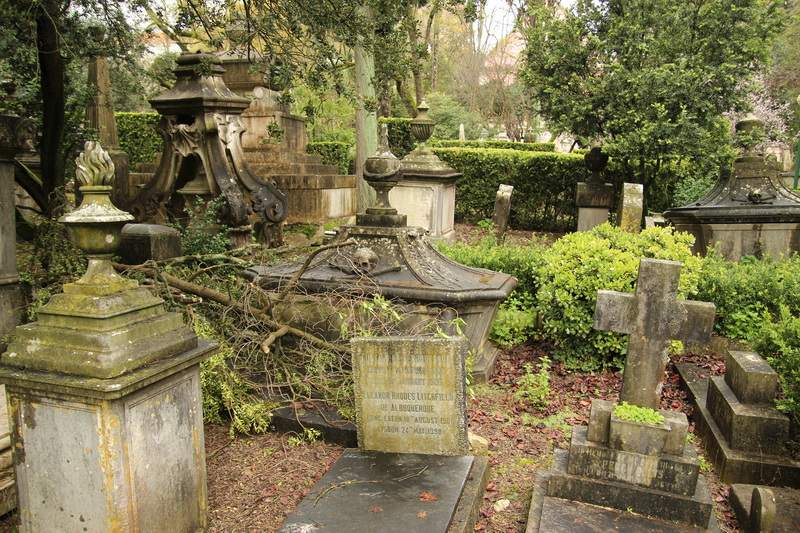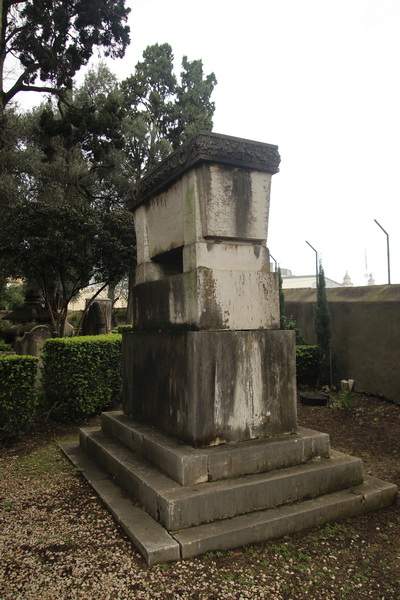Lisbon - Cemitério Inglês
One of the oldest surviving cemeteries for the Dutch in Europe is without a doubt the Dutch Cemetery in Lisbon, today - irony of fate - better known as the British Cemetery. Founded in 1724 on the edge of the former city, the originally Protestant cemetery is now located almost in the center on the north side of the beautiful nineteenth-century park Jardim de Estrela, opposite the rococo basilica of the same name. Once through the gate in the high wall, you imagine yourself in a romantic past, in an oasis of peace, where countless plants and tall trees fight for existence between the sagging monuments of hundreds of years ago.
As early as the seventeenth century, the Netherlands and England maintained intensive trade relations with the strict Catholic Portugal. Import included wood and export salt, a precious commodity at that time. Protestant cemeteries were banned and the bodies of merchants who died on the spot were thrown weighted with stones into the Tagus after midnight according to local custom.
A British trick
The foreign merchants were united in factories, of which the English and Dutch factories were the most important. Political relations through ambassadors existed, but in fact the director of the factory was often also the consul-general of his mother country and he represented the interests of his compatriots locally. After many complaints about the treatment of Protestants in Portugal, the Netherlands seized the opportunity in the peace treaty of 1661 (the restitution of the part of Brazil conquered by Piet Hein to Portugal) under article 15 to acquire the right to “eene bequame en gelegene plaetse tot begraevinge van haer doden” (Editor: “an approved and conveniently located burial site").
 Overview of part of the cemetery (photo Leon Bok, 2014)
Overview of part of the cemetery (photo Leon Bok, 2014)
England also managed to acquire this right at about the same time. Negotiations about place and conditions took quite some time, but finally on 29 December 1724, Consul General Abraham Hijsterman signed the deed, whereby the Republic was given a piece of land of 1,690 square metres as a cemetery on a permanent lease. This piece of land adjoined a plot of land that had already been ceded to the British nation on 1 May 1717, on the same terms. On the Dutch side, the annual ground lease was initially paid from the conservatory treasury of the Dutch, which consisted of the proceeds from contributions on ships. This treasury was closed in 1850, after which the payments were included in the national budget.
Soon the available land proved insufficient and on 22 June 1734, the two nations jointly added another 352 square meters in perpetual leasehold to the two already existing plots. The three plots belonged to the same owner and, as in the first act, it was also now stipulated that the users were not allowed to alienate the land and that they would be managed as one communal cemetery. In 1794 the two nations together built a funeral chapel in classical style, with the inscription: Surrexit impensis brittannorum et batavorum MDCCXCIV. Due to the Napoleonic Wars, which were won in Portugal by the English troops under Wellington for the Allies, there was an urgent need for more land for the many killed soldiers and therefore the English acquired an extra plot on long lease. This opportunity was taken by the then recently established Jewish community of Lisbon to establish their own small graveyard immediately next door.
Just a British Cemetery
The lease was last paid on the Dutch side in January 1958. On 14 November 1958, outside the Netherlands, a deed was signed between representatives of the British Ambassador Charles N. Stirling and the Viscountess of Faial, whereby the latter indicates that she is the owner of the land and that it is sold to the Government of the United Kingdom forever. According to a communication from the British Embassy in 1972, it was uncertain whether the viscountess still had ownership rights, but in fact the entire cemetery has since been registered in the name of the United Kingdom. The Netherlands did not participate in this notarial transfer and the Dutch Embassy in Lisbon was not informed of the negotiations in advance. After the matter was settled, our Embassy received a short note from the British Embassy, informing us that annual ground lease payments no longer had to be made in the future.
 Tombe of Jan Gildemeester (photo Leon Bok, 2014)
Tombe of Jan Gildemeester (photo Leon Bok, 2014)
Due to a lack of interest on the part of the Dutch side, the Dutch interest gradually faded into the background and this oldest cemetery in Portugal is now known exclusively as the British Cemetery. In the second half of the eighties of the last century I actively tried to get this piece of Dutch cultural heritage in the spotlight again. Thanks to the cooperation of then ambassador C.A. van der Klaauw I was given access to all more than 800 archival documents about the cemetery, now in the National Archives. Although almost no documents from the period 1790-2015 are available anymore due to the Napoleonic Wars, a reasonably complete picture of the events over the centuries could be reconstructed. For example, the Consulate General in Lisbon in various cases accurately recorded the circumstances surrounding the death of various persons, sometimes including a list of the personal belongings found. Lunches were organized to obtain contributions from which the Dutch graves could be cleaned and re-lettered. Occasionally Dutch people are still buried here, but now that most of our compatriots no longer live in Lisbon, but prefer Cascais and Estoril, they are often also buried or cremated there, which is also happening more and more in Portugal.
Sources
- Nationaal Archief, Den Haag: Gezantschap in Portugal (Lissabon), (1759) 1888-1954 (1957), nummer toegang 2.05.161, inventarisnummer 144.
Reference: SC-PRT-001
- Last updated on .


